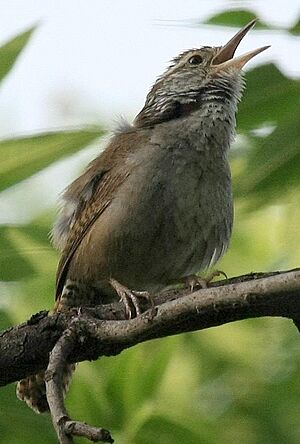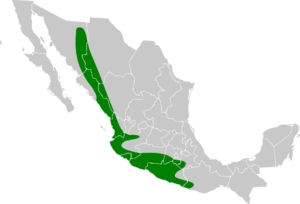Sinaloa wren facts for kids
Quick facts for kids Sinaloa wren |
|
|---|---|
 |
|
| Conservation status | |
| Scientific classification | |
| Genus: |
Thryophilus
|
| Species: |
sinaloa
|
 |
|
| Synonyms | |
|
Thryothorus sinaloa |
|
The Sinaloa wren (Thryophilus sinaloa) is a small bird that belongs to the wren family, Troglodytidae. This bird is special because it is mostly found only in Mexico. This means it is endemic to Mexico. However, people sometimes spot it in the southern part of the United States, especially in Arizona.
Contents
About the Sinaloa Wren
Different Kinds of Sinaloa Wrens
Just like there can be different types of dogs, there are slightly different kinds of Sinaloa wrens. These are called subspecies. The Sinaloa wren has three main subspecies:
- The most common one is called Thryophilus sinaloa sinaloa.
- Another one is T. s. cinereus.
- The third is T. s. russeus.
What Does it Look Like?
The Sinaloa wren is a small bird, usually about 11.8 to 14 centimeters (4.6 to 5.5 inches) long. It weighs about 10.9 to 19.8 grams (0.38 to 0.70 ounces), which is about as much as a few quarters.
Adult wrens have dull brown feathers on their backs. These feathers become a bit more reddish-brown near their tail. Their tail is also reddish-brown with dark stripes.
You can often spot a white or light yellow stripe above their eye, like an eyebrow. They also have a black line behind their eye and white cheeks with dark stripes. The sides of their neck have clear black and white stripes. Their throat and chest are white, turning to a light brown on their sides.
Young wrens look similar, but their sides are lighter and more cinnamon-colored. Their face markings are also not as clear as the adults'.
- The T. s. cinereus subspecies is usually lighter and grayer than the others.
- The T. s. russeus subspecies has a deeper reddish-brown color on its upper body.
Where the Sinaloa Wren Lives
Distribution and Habitat
The Sinaloa wren lives mostly in Mexico. Even though it's a Mexican bird, some wrens fly north and are seen almost every year in southern Arizona.
- The T. s. cinereus subspecies lives in the northern parts of Mexico, from Sonora south to Sinaloa and Chihuahua. It's also the one seen visiting Arizona.
- The T. s. sinaloa subspecies lives in central Sinaloa and Durango, going south to Michoacán.
- The T. s. russeus subspecies is found from central Guerrero east to western Oaxaca.
These birds like to live in the lower parts of deciduous forests. These are forests where trees lose their leaves in certain seasons. They can be found both in untouched forests and in areas where the forest is growing back. They also live in plantations, which are areas where trees are grown for farming.
How the Sinaloa Wren Behaves
What it Eats
The Sinaloa wren mainly eats insects. While we don't know all the details of their diet, they usually look for food close to the ground. Sometimes, they will search for insects as high as 10 meters (33 feet) up in trees. They likely catch their prey by picking insects off leaves and branches.
Reproduction and Nests
Sinaloa wrens usually build their nests and have their young between April and July, after the rainy season. Their nests are shaped a bit like a flask or a bottle. They hang the nest over a thin branch, with the main part of the nest on one side and a tunnel-like entrance on the other.
They build their nests mostly out of grass. Interestingly, they often choose to build their nests close to colonies of aggressive ants or wasps. This might help protect their eggs from other animals! A female wren usually lays four or five eggs at a time.
Vocalizations and Songs
The Sinaloa wren has a very interesting and complex song. People have described it as "loud and varied," with "rich phrases." Others say it has "clear gurgling whistles" mixed with "a rapid series of short trills" [1].
They also make different calls. These can sound like "a rough buzzy rasp" [2] or "a hard, dry chatter" [3].
Conservation Status
The IUCN (International Union for Conservation of Nature) has looked at the Sinaloa wren's population. They have decided that this bird is of "Least Concern." This means that the species is not currently in danger of disappearing.
There are estimated to be more than 500,000 Sinaloa wrens. These birds can live in areas with scrub and new forest growth. This makes them less vulnerable than some other birds that need very specific types of forests to survive.


